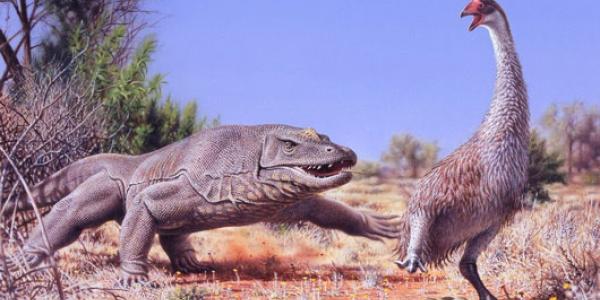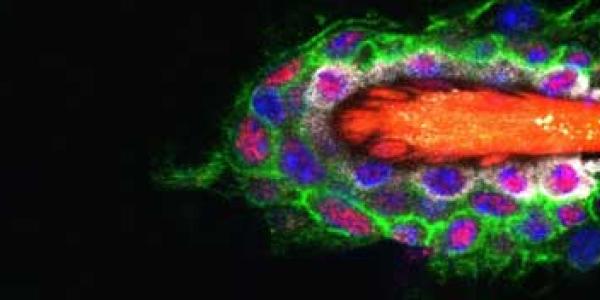
The spruce bark beetle kill in the Gore Range stretches from Dillon many miles to the north.Photo by Jeff Mitton
Bryan Hankinson, a fall 2014 CU-Boulder student who graduated magna cum laude, developed hishonors thesis by investigating the relationship between an increase in spruce bark beetle population and a decrease in American red squirrel population.
Hankinson found that squirrel populations decrease in areas with an increase in beetle-kill trees. The squirrels, primarily seed-consumers, were observed eating beetle larvae from infected Engelmann spruce trees. However, the squirrels weren’t able to glean enough nutritional substance from feeding on the beetle larvae to maintain their population.

Bryan Hankinson
Why squirrels? Hankinson says it’s because “They actually do play a vital role in the ecosystem, especially when it comes to bird species, because they’ve been known to prey upon bird nests, nestlings, and smaller bird species. A lot of people don’t think about squirrels,” chuckles Hankinson.
Hankinson sought to address whether or not American red squirrels were affected by the spruce bark beetle outbreaks in Engelmann spruce forests in Colorado, but he also wanted to study whether the squirrels were successfully adapting to include the beetles in their diet. Hankinson also observed whether the fluctuations in squirrel populations affected cavity-nesting bird populations.
Hankinson and his colleagues gathered their data last summer in the San Juan and Gunnison national forests. They divided the areas into four transects of eight square kilometers of land. The transects were individuated by the relative health of the Engelmann spruces they contained, from containing little to no spruce bark beetle outbreaks to containing high levels of activity, as evidenced by diseased trees.
Those transects were further subdivided into nine point-count stations—areas an observer can record all the pertinent species from for a set amount of time. Starting at 4:30 in the morning, the researchers took around 10 minutes at each station and counted squirrels based on sight and auditory cues. The extensive data collection lasted from the beginning of June to mid-July.
"These habitats are these animals’ homes, and a lot of these animals rely on these habitats in order to live and for their populations to thrive.”
Hankinson counted 76 squirrels throughout the four transects. Only 27 of the squirrels inhabited the diseased, treatment transects—roughly 35 percent of the total squirrels. Hankinson discovered a negative correlation between the red squirrel counts and the number of infected Engelmann spruces, suggesting that the spruce bark beetle outbreaks were in fact negatively affecting American red squirrel populations.
The American red squirrel population probably drops in infected areas of forest because the squirrels in Colorado largely rely on a seed-based diet, according to Hankinson. As the beetles damage the trees, the food source of the squirrels decreases.
This caused Hankinson and his team to question whether the squirrels could adjust using beetles as a replacement food source. Unfortunately, “larvae don’t provide enough caloric substance,” says Hankinson. “Even though the squirrels feed, it doesn’t sustain the population.”
This indicates significant behavioral change in the American red squirrel. The only other study that has observed red squirrels preying on spruce bark beetle larvae was conducted in Canada’s Yukon Territory. No other studies have shown similar behavioral changes in squirrels within Colorado.
Hankinson also used the point-count stations to record the number of birds such as the American three-toed woodpecker. His research demonstrated a negative correlation between squirrel counts and woodpecker counts in the healthy transects, as well as a higher abundance of woodpeckers in the diseased transects. This suggested that the squirrels were preying on woodpecker eggs and nestlings within the nests, decreasing the nest success rate of the birds and lowering their overall population in those areas.
Although he admits it was a lot of work, Hankinson says the research for his thesis was ultimately worth it. Initially, Hankinson didn’t know what the data would indicate. He was satisfied to find that spruce bark beetle outbreaks were actually having an effect on species in Colorado.
“I love the fact that I did this study, and I can put it out there so people know it’s not only affecting us,” says Hankinson. “These habitats are these animals’ homes, and a lot of these animals rely on these habitats in order to live and for their populations to thrive.”
Hankinson notes that spruce bark beetle outbreaks are often reported in the news, and the effects they have on trees, landowners and homeowners are often discussed at length, but creatures like the humble American red squirrel are often neglected. Over time, spruce bark beetle outbreaks have the potential to highly influence entire chains of ecosystems within Engelmann spruce forests.
Hankinson, pursuing a career as a park ranger or wildlife forestry technician with the U.S. Forest Service or National Park Service, found his research as a CU-Boulder undergraduate rewarding. “To be able to write a thesis and put it out there so people know is really satisfying,” remarks Hankinson.
Magdalena Rost, a student majoring in classics and English, is an intern for Colorado Arts & Sciences Magazine.



